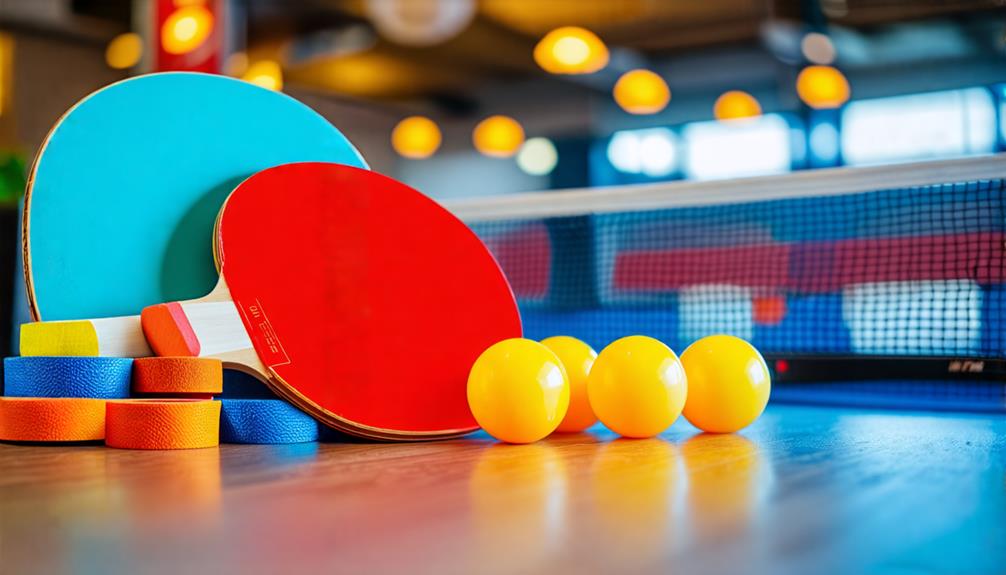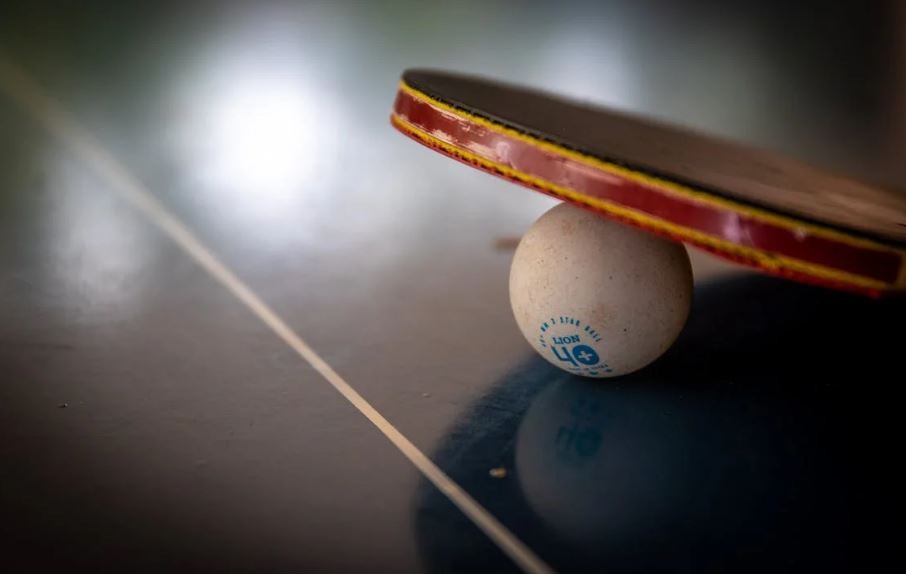How to Create a Ping Pong Tournament in Your Game Room
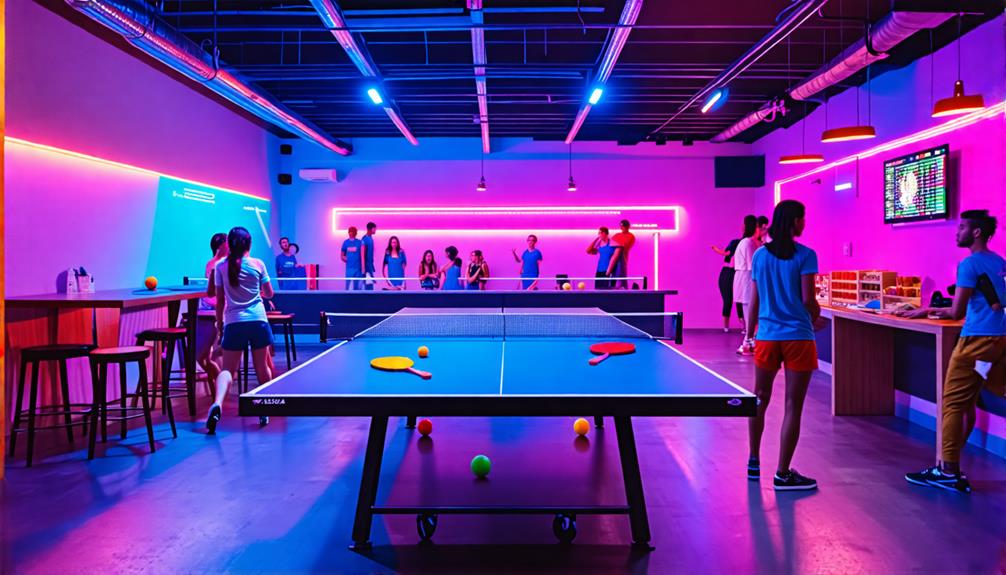
Hosting a ping pong tournament in your game room requires meticulous planning to ensure a smooth and enjoyable event. Start by selecting a date and time that suits both you and your participants. Decide on the tournament format—whether singles or doubles—and establish clear rules for everyone to follow.
But there's more to consider. Several key factors can elevate your tournament from ordinary to exceptional. Here's what you need to include in your checklist:
- Participant Registration: Create a system for participants to sign up, whether through an online form or a physical sign-up sheet in your game room.
- Seeding and Brackets: Use a fair method to seed players and create tournament brackets. Tools like online bracket generators can help.
- Equipment: Ensure you have enough paddles, balls, and tables. Check the condition of your equipment beforehand.
- Scoring System: Decide on the scoring system and make sure all participants are aware of how scores will be kept and reported.
- Refreshments: Provide snacks and drinks to keep participants energized and hydrated throughout the tournament.
- Prizes: Consider offering prizes for the winners to add an element of competition and excitement.
- Rules and Regulations: Clearly communicate the rules and any specific regulations unique to your tournament.
By attending to these details, you'll create a memorable and well-organized ping pong tournament that participants will look forward to.
Benefits of Hosting a Tournament
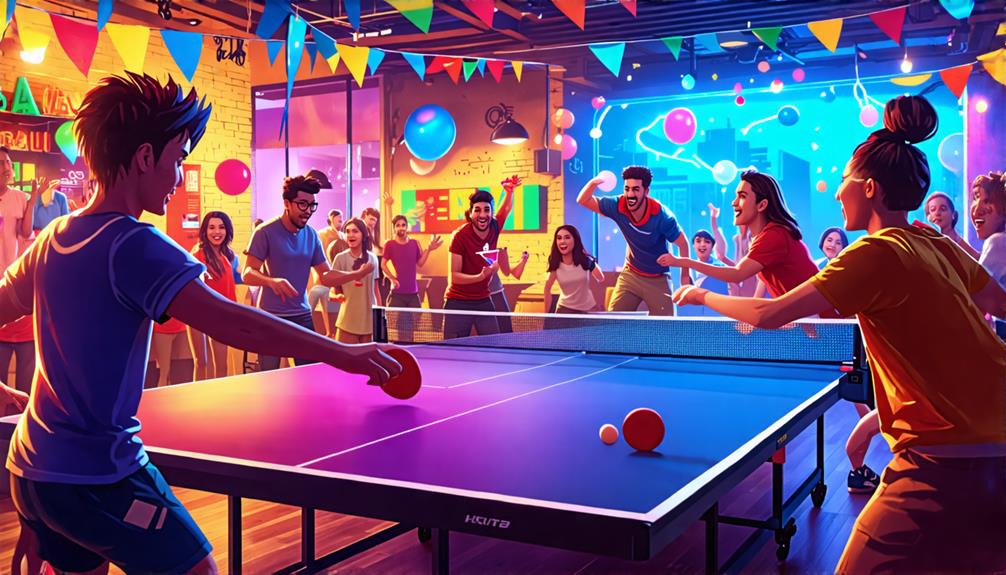
Hosting a ping pong tournament can significantly strengthen bonds among participants and foster a vibrant sense of community. By bringing people together for a shared experience, you create an environment that encourages camaraderie and enhances relationships within your group. Friendly competition sparks motivation, with each match pushing players to refine their skills while enjoying the game.
Additionally, tournaments promote physical activity, which can boost mental well-being. Engaging in a fast-paced game helps relieve stress, enabling participants to focus on the present moment rather than their daily concerns. The inclusive nature of such events welcomes a mix of generations and skill levels, making it accessible to everyone.
The collective excitement of the tournament creates lasting memories, reinforcing the bonds formed during play. As players cheer for each other and celebrate victories, a sense of unity blossoms. This shared experience not only enriches personal relationships but also paves the way for future gatherings. By hosting a ping pong tournament, you aren't merely organizing a game; you're building a community that thrives on camaraderie and the joy of friendly competition.
Planning the Tournament
When planning your ping pong tournament, select a date and time that accommodates all participants to ensure maximum attendance and enjoyment. Once the date is set, distribute the tournament rules and format—whether single-elimination or round-robin—to all players to set clear expectations.
Organize teams and brackets in advance to streamline the competition for both players and spectators. Ensure the availability and good condition of all necessary equipment, such as ping pong tables, paddles, and balls, to avoid any interruptions. Implement a registration process, like online forms, to efficiently collect participant information and assist with logistics planning.
Additionally, consider organizing prizes or recognition for winners, which can be decided by participants prior to the tournament. These steps will help you create a well-organized and enjoyable event for everyone involved.
Essential Equipment Needed
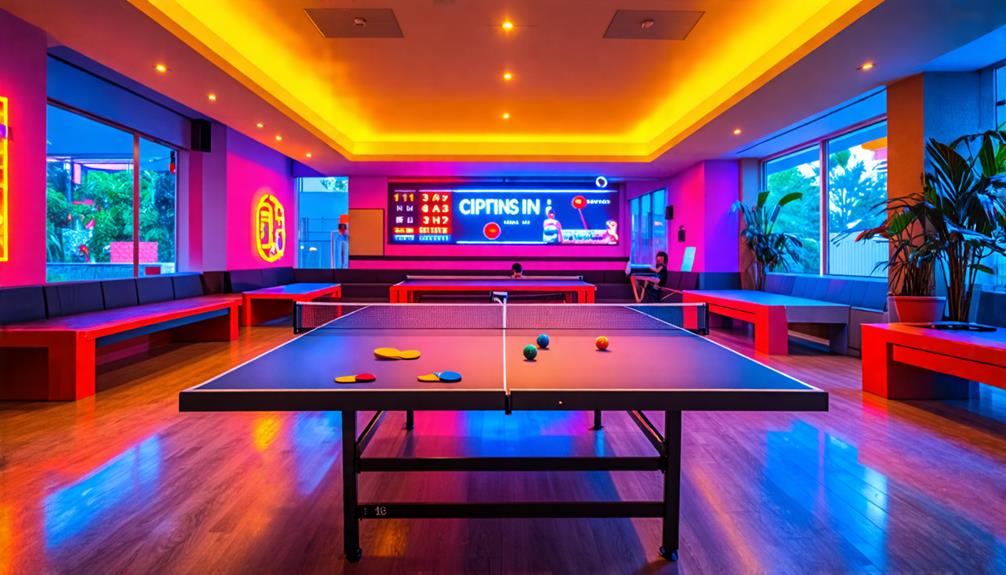
When setting up your ping pong tournament, gather essential equipment to ensure smooth gameplay. Your checklist should include a table, paddles, balls, and a net system. Additionally, consider ideal setup and game accessories to enhance the experience for all participants.
Required Equipment Checklist
To run a successful ping pong tournament, you'll need essential equipment to ensure a smooth and enjoyable experience for all players.
- First and foremost, secure a sturdy ping pong table as the centerpiece for gameplay. If you're hosting a larger group, consider setting up multiple tables to accommodate simultaneous matches.
- Next, stock an adequate number of ping pong paddles—having at least 2-4 paddles will cater to different skill levels and allow for replacements during matches. This ensures everyone can participate without delay.
- Additionally, purchase high-quality ping pong balls in bulk. An unlimited supply is recommended to prevent interruptions during play, particularly for extended tournaments. Ensure you have a reliable net system that's easy to install and durable, guaranteeing proper setup for competitive play.
- Lastly, prepare a bracket board, whether physical or digital, to track matchups and scores. This organization enhances player engagement and ensures everyone knows their standings in the tournament.
With this checklist, you'll be well-equipped to host an exciting ping pong tournament!
Optimal Setup Considerations
Creating an optimal setup for your ping pong tournament requires selecting essential equipment to enhance both gameplay and player experience.
- First, invest in a high-quality ping pong table with standard dimensions of 9 feet long, 5 feet wide, and 30 inches high. This ensures a professional playing surface for all participants.
- Next, provide a range of 2-4 ping pong paddles to cater to different skill levels. This variety allows players to choose paddles that suit their playing style, improving their enjoyment and performance.
Ensure you have at least 20 competition-quality ping pong balls to avoid interruptions during matches. High-quality balls contribute to better gameplay and consistency.
Game Accessories Overview
Equipping your ping pong tournament with the right accessories enhances gameplay and the overall experience for both players and spectators.
- First, a quality ping pong table is essential. The standard dimensions are 9 feet long, 5 feet wide, and 30 inches high, providing the necessary space for competitive play.
- Next, ensure you have 2-4 ping pong paddles to cater to different skill levels, allowing everyone to perform at their best. Stock up on competition-quality ping pong balls—around 50 is ideal to keep matches running smoothly without interruptions.
- An adjustable, durable net system is crucial to withstand intense games.
Additionally, a scoreboard is important for tracking scores and enhancing the competitive atmosphere, keeping everyone updated on match progress.
Choosing the Right Format
Choosing the right tournament format significantly impacts the overall experience and competitiveness of your ping pong event. The format you choose can affect player engagement and the event's duration. For a fast-paced competition, the Single Elimination format is ideal. Players face off in one-match rounds, with winners advancing. This format suits larger groups as it requires only N - 1 matches, where N is the number of participants. If you prefer giving players a second chance, consider the Double Elimination format. Here, each player is allowed one loss before elimination, resulting in 2N - 1 matches. This extended playtime promotes a more competitive environment. For smaller groups, the Round Robin format is worth exploring. In this setup, each participant competes against every other player. Each format has unique advantages, so consider your group size and desired atmosphere before making a decision.
Calculating Game Schedules
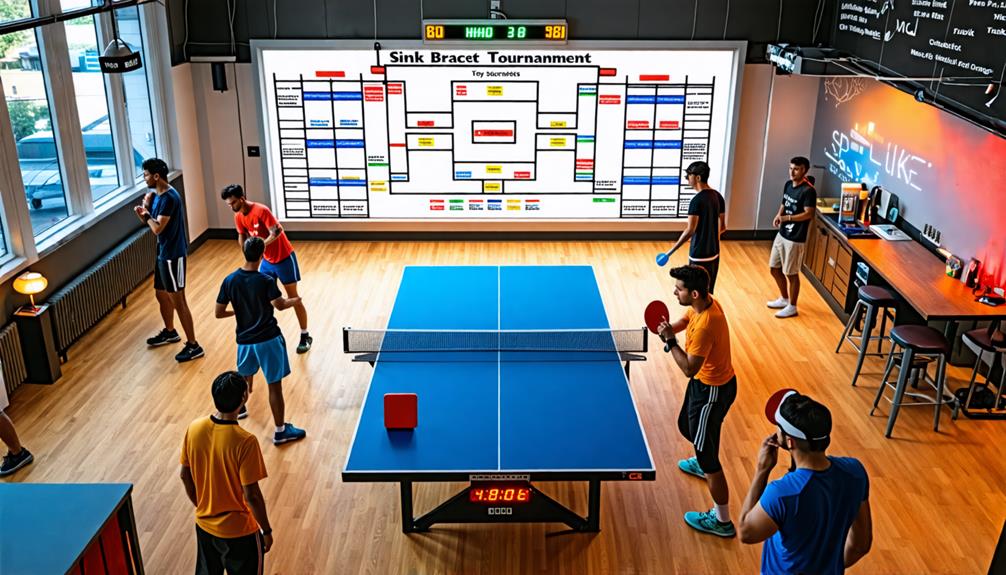
Calculating game schedules is crucial for ensuring that your ping pong tournament runs smoothly and keeps players engaged throughout the event. Here are three key steps to help you calculate the schedule effectively:
1. Determine Your Format: Choose between single elimination, double elimination, or round robin. Each format influences the total number of games differently.
2. Apply the Right Formula:
- For single elimination: Total games = N - 1
- For double elimination: Total games = 2N - 1
3. Schedule Matches: Once you've calculated the total number of games, factor in match durations to allocate time for each round.
Using these calculations ensures that all participants know their match times, keeping the tournament organized. Consider using online scheduling tools to simplify this process. These tools can help you manage your tournament efficiently and keep everyone informed. With a well-structured game schedule, your ping pong tournament will be an enjoyable experience for all involved!
Setting Up the Playing Area
To set up your ping pong tournament, ensure there's adequate space around the table for players to move freely. Organize equipment, such as paddles and balls, so they're easily accessible. A well-arranged playing area enhances the overall experience for participants.
Space Requirements and Layout
When organizing your ping pong tournament, ensure you have ample space to set up at least two tables for concurrent matches. Each table requires a minimum area of 12 feet by 20 feet, with an additional 5 feet of clearance around it. This setup allows players to serve and move freely without any obstructions.
Key considerations for an effective layout include:
- Ceiling Height: Ensure a minimum ceiling height of 8 to 10 feet to prevent high shots from hitting the ceiling and to maintain a comfortable atmosphere.
- Lighting: Use overhead LED fixtures or construction lights to provide adequate illumination, especially for evening games. Proper lighting is crucial for visibility and optimal player performance.
- Spectator Seating: Arrange seating around the playing area to enhance the viewing experience. Ensure spectators are positioned at a safe distance from the playing area to prevent any accidents.
Adhering to these space requirements will help you create a functional and enjoyable playing environment for your tournament.
Equipment Organization and Accessibility
Efficiently organizing your equipment ensures that players can quickly access paddles and balls, maintaining the smooth flow of the tournament.
- Begin by positioning the ping pong table in a spacious area, ensuring at least 5 feet of clearance on all sides. This space allows players to move comfortably during matches.
- Next, focus on equipment organization. Store paddles and ping pong balls in easily accessible bins or shelves near the playing area. This setup facilitates quick retrieval, preventing any delays during the tournament.
- Designate a scoring area close to the table, complete with a scoreboard and a clear view of match brackets. This keeps participants informed and engaged throughout the event.
- Proper lighting is also crucial; consider using construction lights or overhead fixtures to enhance visibility, especially during evening tournaments.
- Lastly, create a comfortable viewing area with seating for spectators. This not only enhances the atmosphere but also keeps the audience engaged with the games.
Organizing Prizes and Rewards

Organizing attractive prizes and rewards can significantly boost participation and enthusiasm in your ping pong tournament. Knowing there are rewards at stake encourages players to perform their best.
Here are three ideas to consider:
- Trophies or Medals: Award winners with trophies or medals. These symbolic prizes not only enhance the competitive spirit but also serve as lasting mementos of their achievements.
- Gift Cards: Provide gift cards to local restaurants or stores. This flexible option caters to various preferences, making it appealing to a broader range of participants who can use the prizes as they wish.
- Fun Merchandise: Offer unique ping pong-themed gadgets or merchandise as prizes. These items resonate with players and create a memorable experience.
Consider funding a prize pool through a small registration fee to generate excitement and financial incentives for winning.
Additionally, special awards like 'Best Sportsmanship' or 'Funniest Player' can recognize diverse contributions, making your tournament more inclusive and engaging for everyone involved.
Enhancing the Tournament Experience
How can you transform your ping pong tournament into an unforgettable experience for everyone involved? Start by creating an immersive atmosphere with themed decorations and snacks. For instance, a retro 1980s vibe with neon colors and popular snacks from that time can set the tone.
Next, curate a playlist of upbeat music to energize the environment and elevate player morale throughout the tournament. Capture memorable moments by hiring a photographer or designating someone to take photos and videos for social media sharing. This not only enhances the tournament experience but also creates lasting memories for players and spectators alike. To keep participants engaged while waiting for their turn to play, organize mini-games or fun challenges between matches. This adds an element of excitement and camaraderie among the players.
Marketing Your Event
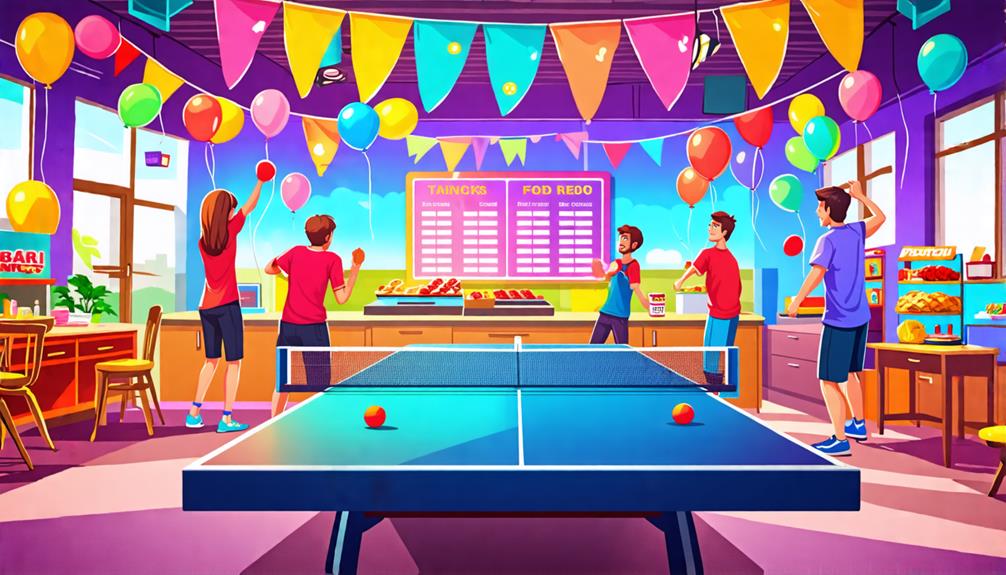
To effectively promote your ping pong tournament, leverage social media platforms, design visually appealing digital invitations, and foster partnerships with local businesses. These strategies not only amplify your event's visibility but also generate excitement that attracts participants. Let's explore how each tactic can enhance your tournament's reach and success.
Social Media Promotion
Social media is a powerful tool for promoting your ping pong tournament, allowing you to reach a wider audience and generate excitement around the event. By leveraging various platforms, you can create engaging content that highlights all the crucial details. Here are three effective strategies to enhance your visibility:
- Create Event Pages: Utilize Facebook and Instagram to set up dedicated event pages. Share engaging content that details tournament rules, prizes, and registration information to attract participants.
- Visual Appeal: Design eye-catching graphics and videos showcasing previous tournaments or sneak peeks of what's to come. This excites your audience and encourages shares, amplifying your reach.
- Community Engagement: Tap into local community groups on social media to spread the word. Encourage participants to tag your event and use a unique hashtag, fostering a sense of community and increasing visibility across platforms.
Additionally, share live updates during the tournament, including match results and highlights. This keeps your audience engaged and encourages them to follow your future events, making your ping pong tournament a must-attend local attraction!
Digital Invitations Strategy
Creating digital invitations is crucial for effectively marketing your ping pong tournament and ensuring a strong turnout. Start by utilizing social media platforms like Facebook and Instagram to create event pages with eye-catching graphics. Highlight the tournament details and incorporate a clear call-to-action that encourages participants to RSVP.
Leverage email marketing tools to send personalized digital invitations, making it easy for potential players to register and share the event with friends. Consider using platforms like Eventbrite or Meetup to streamline the registration process and send reminders as the event date approaches.
To capture attention, incorporate engaging visuals such as videos or GIFs in your digital invitations, conveying the excitement of your tournament. Furthermore, to motivate participants to bring friends, offer incentives like discounted tournament fees or special prizes for those who register extra players. This not only enhances attendance but also fosters a fun, competitive atmosphere.
Local Partnerships Engagement
Engaging local partnerships can significantly enhance your ping pong tournament's appeal and foster a vibrant community atmosphere. By collaborating with local businesses, you can enrich the overall experience for everyone involved.
Here are three effective ways to leverage these partnerships:
- Sponsorship Opportunities: Partner with local businesses to sponsor prizes or refreshments. Displaying their logos on tournament materials or social media provides them with exposure while strengthening community ties.
- Promotional Discounts: Collaborate with nearby sports shops to offer discounts on equipment for participants. This not only incentivizes attendance but also builds goodwill among local retailers.
- Media Coverage: Engage local media outlets to cover your tournament. Increased visibility will attract more participants and spectators, benefiting both your event and local businesses.
Gathering Feedback for Improvement
To enhance your next ping pong tournament, gather participant feedback immediately after the event to capture their fresh impressions and suggestions. Utilize surveys or informal discussions to collect this valuable information. A structured feedback form with questions about tournament organization, equipment quality, and overall enjoyment can help you gather quantitative data for analysis.
Encourage participants to provide specific examples of what they liked or disliked, aiding in identifying actionable areas for improvement. For instance, if multiple players mention the need for better paddles or more efficient scheduling, these concerns can be addressed.
Consider hosting a follow-up meeting with key volunteers or organizers to review the feedback. This collaborative approach can spark brainstorming sessions to improve future tournaments. After gathering and analyzing the feedback, implement changes that reflect participant suggestions, such as adjusting the tournament format or upgrading equipment.
Conclusion
Hosting a ping pong tournament in your game room can be a fantastic way to bring friends and family together for some friendly competition. By planning carefully and ensuring you have everything in place—such as a well-maintained table, paddles, and a clear set of rules—you'll create an enjoyable experience for everyone involved. Promote your event in advance and gather feedback afterward to improve future tournaments. Grab those paddles and start organizing your tournament, and you're sure to create unforgettable memories!
